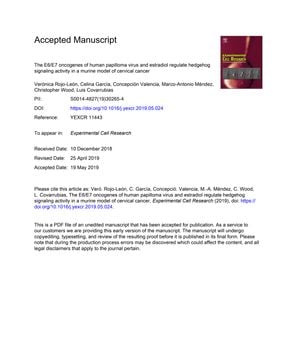The E6/E7 oncogenes of human papilloma virus and estradiol regulate hedgehog signaling activity in a murine model of cervical cancer
August 2019
in “Experimental Cell Research”

TLDR HPV genes and estradiol increase a cancer-related signaling pathway, which may be targeted for cervical cancer treatment.
The document from August 1, 2019, presents a study that explored the effects of human papillomavirus (HPV) E6/E7 oncogenes and estradiol on the hedgehog (Hh) signaling pathway in a murine model of cervical cancer. The study demonstrated that both E6/E7 oncogenes and estradiol increased Hh signaling, which correlated with increased growth of cervical epithelium and skin. The use of itraconazole (ITC), a hedgehog pathway inhibitor, was found to reduce the proliferation of HeLa cells and decrease cervical epithelium growth and dysplasia in mice, although it did not affect Hh signaling. The study involved a small number of mice (n=2 for each transgenic mouse group treated with estradiol for 50 days). These findings suggest that targeting the Hh signaling pathway could be a potential strategy for cervical cancer treatment, and that ITC may be effective in reducing cervical growth through mechanisms other than Hh signaling inhibition.
View this study on doi.org →
Cited in this study

research Human Papillomavirus E6/E7 Oncogenes Promote Mouse Ear Regeneration by Increasing the Rate of Wound Re-epithelization and Epidermal Growth
HPV genes in mice improve ear tissue healing by speeding up skin growth and repair.

research Induction of the hair growth phase in postnatal mice by localized transient expression of Sonic hedgehog
Activating the Sonic hedgehog gene in mice can start the hair growth phase.
research An estrogen receptor pathway regulates the telogen-anagen hair follicle transition and influences epidermal cell proliferation.
Estrogen affects hair growth and skin cell multiplication.
Related

research The Effects of Sonic, Desert, and Indian Hedgehog Signaling in Skin
This study investigates the roles of Sonic hedgehog (Shh), Desert hedgehog (Dhh), and Indian hedgehog (Ihh) signaling in skin development and maintenance. Using transgenic mice, the research reveals that Shh and Dhh overexpression leads to novel skin phenotypes, Wrinkled and Translucent, characterized by abnormal stem cell populations and basal cell carcinoma (BCC)-like lesions. Ihh overexpression did not affect skin phenotype, indicating it is not a functional homologue of Shh in skin development. The findings suggest that Shh and Dhh regulate epidermal stem cell proliferation and maintenance, and aberrant Shh signaling can lead to tumor formation.